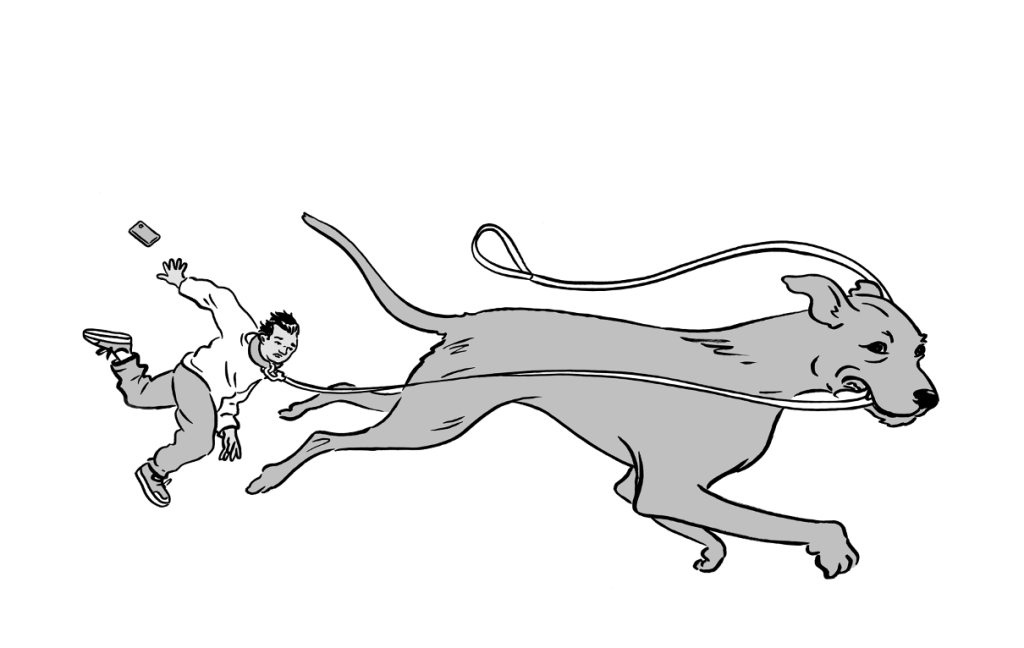Pets and Their People Blog
What Do the Boy Scouts of America and U.S. Dog Trainers Have in Common?
A Lot, the Fox Is in the Henhouse
By Annie Phenix and Pilley Bianchi

Best-selling authors Annie Phenix and Pilley Bianchi have teamed up to write a compelling, fact-based news article that examines how family dogs are living in a time of major transition as they become more and more embedded in our families. More is expected of them, and more often than not, people expect their dogs to inherently know the rules of order. Sit, stay, come, chew this, not that. But despite 40,000 years by our side, dogs are not preprogrammed to know what to do in the human home. With more people writing about dogs in concert with social media posts, discerning fact from fad is very challenging. Particularly for the dog. Currently, there are no regulations or certifications necessary for dog trainers, which has created a popular subculture of abusive trainers with shocking methods. Literally shocking their dogs. Now the fox is in the henhouse and there are no guardrails to protect dogs anywhere in the United States. But there are things we can do.
It was a midday fall walk for professional dog trainer June Walker* and Bella, her six-year-old heeler-mix dog, when their paths intersected with another canine–human duo. The pup appeared first, an adorable 20-pound white dog, and at the other end of the leash was a very large man. Not an unusual pair in the park—there are odd couples everywhere—however, Walker’s smile quickly faded when she noticed the little pup panting excessively, flinching, and rapidly squinting his eyes. Her eyes traveled up the leash to where she observed the guy’s hand stuffed into the pocket of his shorts. As he moved his hand in his pocket, she quickly recognized the pup reacting in pain, noticing the tightly placed shock collar around his neck.
Walker is a not only an expert in canine behavior, but she holds many industry certifications. She is a certified bite prevention educator and end-of-life doula for companion animals. She is the owner of a professional dog training company, and it is literally her job to know when an animal is communicating fear, pain, or anxiety. Studying canine behavior for decades, she is often called into court cases as an expert witness to describe a dog’s communication and behavior to juries.
Instinctively she blurted out, “Oh my God, you are shocking that little dog, please stop!”
Walker is not a novice to this situation, and normally she would diplomatically ask the guardian if they would be open to exploring a different way to modify the pup’s behavior. But she had reached a boiling point. She was already reeling from an experience where she was brought in to replace a previous trainer. The family’s golden retriever was constantly jumping up on their son, so to curb this behavior, the trainer prescribed a shock collar and advised them to zap the dog every time he was near the boy. The dog quickly connected these dots, determining that close proximity to the child equaled pain. After what would become the final shock, in an act of self-protection, the dog bit the boy on his face.
No happy ending for the child or the pup.
This memory was etched into Walker’s mind as she continued, “The dog was walking past us doing absolutely nothing wrong—just a polite heel with no barking, snarling, or pulling—and got shocked for it.” As the guy breezed past her, he smirked, “The dog is fine, and have a nice day.”
Walker’s story is not unique, and it exemplifies the “fox in the henhouse” metaphor that is often used to express an unfair power dynamic that is primarily defined as predatory (exploiting situations or people), tyrannical (misusing trust for personal gain), and untrustworthy (having harmful or manipulative intentions).
What does this metaphor have to do with dog training?
Dogs are a vulnerable population. Similar to children, they don’t ask to come into our individual orbits. But unlike children, dogs never have the choice to leave, speak up, or explore who they are truly meant to be—unless we help them.
Currently there are no certifications needed to bring an animal home or label yourself a trainer. No specific knowledge is necessary, nor are there guardrails federally or locally to protect dogs who are at the mercy of whoever walks them through the door of a home. And too many times, tragically, poor training is built upon ignorance or is simply a vehicle of human cruelty. Neither of these is easy to tackle. Education is an ongoing process to deliver valuable information that can reach a receptive audience. Cruelty is a more slippery slope regarding animal welfare because there are very few consequences. And in the United States, we not only allow it, but we also market it (Sherdan, 2024).
Shock collars (also known as e-collars, GPS collars, GPS fence, etc.) appeared in the 1960s as tools for controlling hunting dogs at a distance (Shock collar, 2024) and have since developed into a widely popular “training” mechanism for family dogs, netting companies up to $25 million a year. This is despite the recommendations and evidence offered by the Pet Professional Guild (Shock-Free Coalition, n.d.), American Veterinary Society of Animal Behavior (AVSAB, 2021), and American Animal Hospital Association (Hammerle et al., 2015) to ban these unregulated devices.
Websites that sell these expensive collars often use deceptive language that encourages dog owners to believe that shock collars are not painful to their dogs. This is false and, disturbingly, there is a vast population in the dog training culture that not only profits, but also preys on the vulnerability of dogs. Marc Bekoff of Psychology Today and author of Dogs Demystified openly refers to these methods as the “dirty little secret” of dog training (Bekoff, 2017). This is not dissimilar to the entities and individuals that have exploited children entrusted to their care: the Boy Scouts of America (BSA), the Catholic Church, and Michigan State University and USA Gymnastics (in the case of Olympic gymnastics doctor Larry Nassar).
These are just a few of the esteemed institutions and trusted professionals that gratuitously turned a blind eye to the decades-long abuse of children. The pertinent question is, “Why and how could this behavior fly under the radar with abuses reported over 82,000 times (Knauth, 2024)?” To date, the BSA has been hit with a $2.46 billion dollar settlement for the indisputable harm permitted under their watch (Berman, 2023), and in recent decades the Catholic diocese has paid more than $3 billion dollars in settlements (Meneo, n.d.). After Larry Nassar pleaded guilty, his sentence was 80 to 300 years in Michigan State Prison (Larry Nassar, 2024).
Let’s pivot back to our relationship with dogs to explore why we are making these comparisons. Scientifically, research confirms that dogs and children share many emotional and cognitive similarities that are grounded through 40,000 years of a shared evolutionary path (Pilley & Reid, 2011; Pilley, 2013). Without the similes, as well as an understanding of our historic journey together, empathy is a challenge. In similar fashion to the BSA, it is time to hold e-collar manufacturers accountable, and educate pet parents about humane canine welfare.
E-collars have been banned in most European countries: Germany, Italy, Luxembourg, the Netherlands, Portugal, Wales (The Kennel Club, n.d.), and Spain. Also, in countries like the United Kingdom and Australia, significant efforts have been made to outlaw these devices, and the American Veterinary Society of Animal Behavior confirms that there is no role for these aversive methods in training (AVSAB, 2021). They can cause burns, skin irritation, and even open wounds. In addition, the tight-fitting collars can restrict a dog’s breathing and cause neck injuries. Aside from burns, the electric shock delivered by an e-collar can cause muscle damage (Cain, 2022), thyroid damage, neck injuries, eye, and ear damage, and even cardiac arrest.
Alexandra Horowitz, a dog behavior expert at Barnard College and author of Inside of a Dog, was instrumental in having these devices banned at Petco. She describes the psychological effect as follows:
Shock collars are weapons, and I don’t use weapons with any dog—and it would certainly seem bizarre to do so with an animal who I consider to be a member of the family (as 95% of owners do). The collars are meant to produce pain and discomfort—and they do. They are also confusing to dogs: it’s very difficult to time the shock/vibration so perfectly that the dog knows what behavior they’ve done that’s being punished. Instead, dogs just become generally more stressed and anxious, given that shocks appear seemingly out of nowhere, for nothing clear that they’ve done. Worse, research has shown that long-term use, far from solving the “misbehavior”, actually increases dogs’ fear and aggression toward the person delivering the shock. Plus, comparisons of the efficacy of training techniques has found repeatedly that positive reinforcement methods are more effective at producing desired behaviors than punishment-based training. It’s a no-brainer: do not shock (Personal communication, PB).
Mia Cobb, canine welfare researcher at the University of Melbourne, concurs:
Devices that deliver electric shocks are unnecessary (RSPCA Knowledgebase, n.d.) and have no place in our modern relationships with dogs. In 2024, we have an excellent understanding of how to shape behavior positively, without the need for crude tools that punish by inflicting pain, causing fear and discomfort. Such collars hurt dogs physically and mentally and erode the relationship between people and dogs. The evidence shows that reward-based training is effective and serves to strengthen our bond with dogs (Personal communication, PB).
There are many resources to inform on how we can increase our interspecies bond, not shrink it. Start by following Dr. Zazie Todd and Companion Animal Psychology (link in the Resources for Dog Guardians section below).
As responsible pet parents, stop purchasing painful devices, which are never simply a “stim” or a tap. Stop buying pinch, prong or choke collars, electric fences, or anti-bark devices. If you wouldn’t like it, neither would your dog.

A critical question to ask ourselves in moving forward is, “At what point is silence a sin?” Report ads for painful collars as abusive that come across your feed on social media and block them. Advocate for compassionate handling of your dog from everyone, including your veterinarian and staff and anyone calling themselves a trainer. Walk away from those who want to use force and shut down your pup, and remember that the quality of the relationship dictates the quality of learning—you get what you give.
Hopefully, we’ve learned from past experiences not to leave our children with unvetted institutions or adults, so it’s time to properly research dog trainers with whom we will be trusting our beloved pets in an unregulated market. The BSA and Catholic diocese were eventually held accountable for their abusive practices, pulling back the curtain on how we failed a vulnerable population—let’s do better for our beloved dogs.
John W. Pilley, canine researcher and teacher to Chaser, known as “the smartest dog in the world,” said it well: “There is one thing you must do to explore learning with your dog or any animal. Respect the other mind involved with you in the process” (Pilley & Heath, 2023).
*June Walker is a pseudonym. We chose to use a pseudonym because of the extreme hostility between canine trainers who choose to train without force and those who do. Remarkably, many of us receive death threats and weekly cyberbullying.

Annie Phenix, ACB- KSA, has achieved many certifications including Certified Canine Behaviourist (INTODogs), Family Dog Mediator (FDM), CPDT-KA (Retired), Fear Free Certified Professional, Graduate of a Schutzhund Dog Academy, CGC Evaluator, Nose Work Instructor, and many others. She belongs to several professional organizations such as the Pet Professional Guild, Pet Industry Advocacy International, the UK Dog Charter, and the International Companion Animal Network. She is a lifetime advocate of training dogs without the need for fear, force, or pain and with compassion and science-backed methods. She owns an internationally respected training company called Choose to Train Humane®. Phenix is the author of The Midnight Dog Walkers: Positive Training and Practical Advice for Living with Reactive and Aggressive Dogs (Fox Chapel Publishing, 2016). Her book was nominated for a Maxwell Award for best behavior book of the year by the Dog Writers Association of America. She recently wrote her second best-selling book on canine behavior concerns and solutions titled Positive Training for Aggressive and Reactive Dogs: Proven Techniques to Help Your Dog Overcome Fear and Anxiety (CompanionHouse Books, 2023). Phenix founded the Phenix Advocacy Center for R+ Canine Professionals (PAC) in 2023. The PAC is a peer-to-peer nonprofit that works to educate canine pros on the vital topic of mental health and well-being.

Pilley Bianchi is the author of For the Love of Dog, The Ultimate Relationship Guide with New York Times illustrator Calum Heath and a contributing editor for Inside Your Dog’s Mind magazine. She is the youngest daughter of Dr. John W. Pilley, owner/teacher of Chaser the Border Collie. Known as “the smartest dog in the world,” Chaser has the largest formal language learning of any animal in the world. Bianchi has been a co-trainer, producer, writer, and media consultant for Chaser featured in Time, People, Popular Science, The New York Times, and Modern Dog, and film shoots with 60 Minutes, CBS, NBC, ABC, BBC, ITV, and Discovery. Bianchi collaborated with her father and his co-writer, Hilary Hinzmann, behind the scenes on their New York Times best-selling book, Chaser, Unlocking the Genius of the Dog Who Knows 1000 Words, and has appeared as an expert on Chaser at SXSW, Hill’s Science Diet, Fox & Friends, PBS, Dogspot.in India, CBC Canada, SBS TV South Korea, WIRED, the AKC, the ASPCA, the IAABC, NPR Canada, and Talk RADIO London. Bianchi is senior executive producer/founder of The Chaser Initiative, a new non-profit dedicated to educating children (K-12) about the legacy of John Pilley and Chaser, as well as promoting animal welfare science.
About the Illustrator
Calum Heath is the illustrator of the best-selling book, For the Love of Dog, and the New York Times illustrator for Connections Companion, The New Yorker, Washington Post, Bloomberg, WIRED, Los Angeles Times, Politico, and VICE.
References
AVSAB. (2021). Position statement on humane dog training. American Veterinary Society on Animal Behavior. https://avsab.org/wp-content/uploads/2021/08/AVSAB-Humane-Dog-Training-Position-Statement-2021.pdf
Bekoff, M. (2017, January 19). Dog training’s dirty little secret: anyone can legally do it. Psychology Today. https://www.psychologytoday.com/us/blog/animal-emotions/201701/dog-trainings-dirty-little-secret-anyone-can-legally-do-it
Berman, P. (2023, August 18). Boy Scouts processing sexual abuse claims in $2.46 billion settlement. CBS News, Philadelphia. https://www.cbsnews.com/philadelphia/news/boy-scouts-processing-sexual-abuse-claims-in-2-46-billion-settlement/
Cain, E. (2022, December 5). The dangers of dog shock collars. Pet Insurance Review. https://www.petinsurancereview.com/blog/the-dangers-of-dog-shock-collars
Hammerle, M., Horst, C., Levine, E., Overall, K., Radosta, L., Rafter-Ritchie, M, & Yin, S. (2015). 2015 AAHA canine and feline behavior management guidelines. American Animal Hospital Association. https://www.aaha.org/wp-content/uploads/globalassets/02-guidelines/behavior-management/2015_aaha_canine_and_feline_behavior_management_guidelines_final.pdf
Knauth, D. (2024, February 22). US Supreme Court lets $2.46 billion Boy Scouts sex abuse settlement proceed. Reuters. https://www.reuters.com/legal/us-supreme-court-lets-246-billion-boy-scouts-sex-abuse-settlement-proceed-2024-02-22/#:~:text=The%20settlement%20involves%20more%20than,the%20agreement%20in%20bankruptcy%20court
Larry Nassar. (2024, June 27). In Wikipedia. https://en.wikipedia.org/wiki/Larry_Nassar
Meneo, R. (n.d.). Catholic Church settlements. Abuse Lawsuit. https://www.abuselawsuit.com/church-sex-abuse/settlements/
Pilley, B. & Heath, C. (2023). For the Love of Dog, the Ultimate Relationship Guide. Princeton Architectural Press.
Pilley, J.W. (2013). Border collie comprehends sentences containing a prepositional object, verb, and direct object. Learning and Motivation, 44(4), 229-240. https://doi.org/10.1016/j.lmot.2013.02.003
Pilley, J.W. & Reid, A.K. (2011). Border collie comprehends object names as verbal referents. Behavioural Processes, 86(2), 184-195. https://doi.org/10.1016/j.beproc.2010.11.007
RSPCA Knowledgebase. (n.d.). What are the animal welfare issues with electric shock collars on dogs? Retrieved June 27, 2024, from https://kb.rspca.org.au/knowledge-base/what-are-the-animal-welfare-issues-with-electric-shock-collars-on-dogs/
Sherdan, M. (2024, March 7). 5 best shock collars for dogs, according to trainers. StudyFinds. https://studyfinds.org/best-shock-collars-for-dogs/
Shock collar. (2024, June 27). In Wikipedia. https://en.wikipedia.org/wiki/Shock_collar
Shock-Free Coalition (n.d.). Pet Professional Guild. https://www.petprofessionalguild.com/advocacy/shock-free-coalition/
The Kennel Club. (n.d.). Electric shock collars. Retrieved June 27, 2024, from https://www.thekennelclub.org.uk/about-us/campaigns/electric-shock-collars/
Additional Reading
Barks from the Guild. (2018, August 28). Pet Professional Guild responds to the UK government’s decision to ban electronic shock collars in pet training, care, behavior modification, and management. Retrieved July 1, 2024, from
https://www.petprofessionalguild.com/barks/barks-magazine-blog/pet-professional-guild-responds-to-the-uk-governments-decision-to-ban-electronic-shock-collars-in-pet-training-care-behavior-modification-and-management/
Crane, E. (2017, October 31). Married couple ‘severely abused three young children with belts, switches and dog shock collars – and forced them to brush their teeth with cat feces’. Daily Mail. https://www.dailymail.co.uk/news/article-5036751/Couple-accused-severely-abusing-three-young-children.html
de Castro, A.C.V., Fuchs, D., Morello, G.M., Pastur, S., de Sousa, L., & Olsson, I.A.S. (2020). Does training method matter? Evidence for the negative impact of aversive-based methods on companion dog welfare. PLoS One. https://doi.org/10.1371/journal.pone.0225023
Ellich, J.D.J. (2022, October 25). Former Somerset jail guard sentenced for placing dog shock collar on his children. Daily American.
Hettinger, J. (n.d.). How to find a dog trainer. The Humane Society of the United States. https://www.humanesociety.org/resources/how-find-dog-trainer
Horowitz, A. (2023, August 1). Consider this before you judge Commander (or any other dog). The New York Times. https://www.nytimes.com/2023/08/01/opinion/commander-biden-dog-biting-german-shepherd.html?searchResultPosition=1
Horton, A. (2023, September 6). ‘Vastly worse than other scandals”: new film explores sexual abuse in Boy Scouts. The Guardian.
https://www.theguardian.com/film/2023/sep/06/boy-scouts-america-documentary-netflix
Johnson, R. (2023, September 6). ‘Scouts Honor’: a new doc details the secret files of the Boy Scouts. Tudum by Netflix.
https://www.netflix.com/tudum/articles/scouts-honor-the-secret-files-of-the-boy-scouts-of-america-release-date-news
Mindock, C. (2019, May 31). Circus promoter couple ‘fatally abused son with starvation and dog shock collar’. Independent.
https://www.independent.co.uk/news/world/americas/circus-couple-abuse-child-starve-dog-collar-shock-indiana-a8939181.html
Nieto-Munoz, S., Napoliello, A., & Goldman, J. (2019, April 23). Boy Scouts ‘Perversion Files’ includes 52 former N.J. scout leaders. Law firm says there were 12K victims nationally. NJ.
https://www.nj.com/news/2019/04/boys-scouts-perversion-files-list-includes-52-former-nj-scout-leaders-law-firm-says-there-were-12k-victims-nationally.html
RSPCA. (n.d.). Why prong collars are harmful to dogs. Retrieved July 1, 2024, from https://www.rspca.org.uk/adviceandwelfare/pets/dogs/training/prongcollars
RSPCA Knowledgebase. (n.d.). Are pronged collars harmful to my dog? Retrieved July 1, 2024, from https://kb.rspca.org.au/knowledge-base/are-pronged-collars-harmful-to-my-dog/
Scottish Government. (2018, October 15). Dog training aids: guidance. Retrieved July 1, 2024, from https://www.gov.scot/publications/guidance-dog-training-aids/
Searles, K. (2017, April 24). Former Nashville Boy Scouts leader pleads guilty to sexual battery charges. Fox 17. https://fox17.com/news/local/former-nashville-boy-scouts-leader-pleads-guilty-to-sexual-battery-charges
The Guardian. (2016, July 11). Woman jailed for using electric shock dog collar on toddler. Retrieved June 27, 2024, from
Todd, Z. (2018, June 20). Study outlines reasons to ban electronic collars for dogs. Companion Animal Psychology. https://www.companionanimalpsychology.com/2018/06/study-outlines-reasons-to-ban.html
Yip, R. (2022, May 6). Dog trainers, pet owners warn against use of ‘e-collar’ shock collars. ABC 7 News. https://abc7news.com/dog-shock-collar-e-warning-training/11821836/
Resources for Dog Guardians
The Pet Professional Guild’s Shock-Free Coalition
Annie Phenix’s bestselling training book, Positive Training for Aggressive and Reactive Dogs: Proven Techniques to Help Your Dog Overcome Fear and Anxiety
Pilley Bianchi and Calum Heath’s bestselling canine book, For the Love of Dog: The Ultimate Relationship Guide
Marc Bekoff’s book, Dogs Demystified: An A-to-Z Guide to All Things Canine
Alexandra Horowitz’s book, Inside of a Dog: What Dogs See, Smell, and Know
Dr. Zazie Todd’s blog, Companion Animal Psychology
Dr. John Pilley’s website, Chaser the Border Collie, the Smartest Dog in the World

